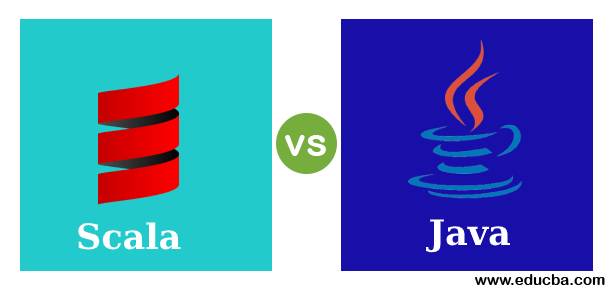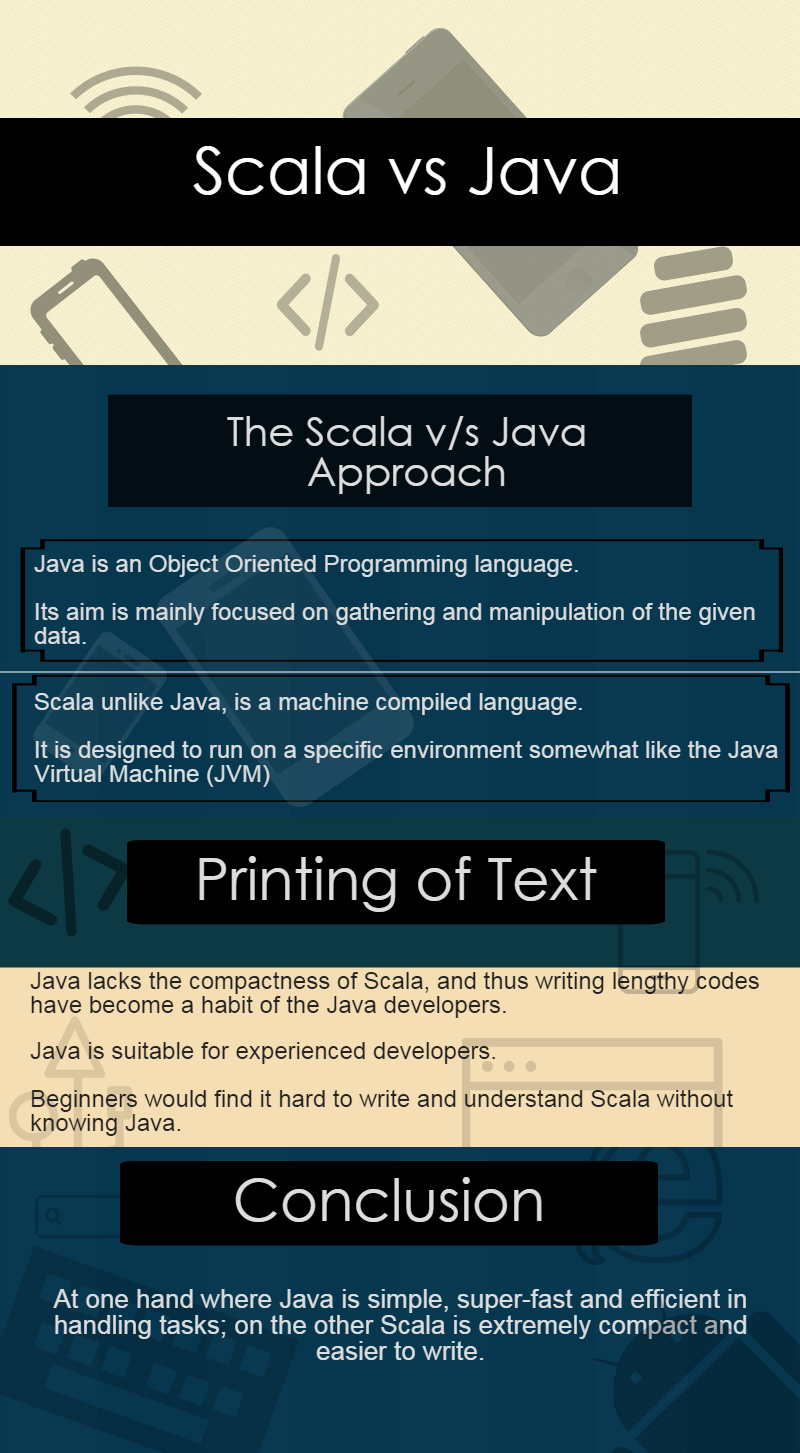
Difference Between Scala vs Java Performance
Scala vs Java Performance – Welcome to the Ultimate Battle of the Century. Scala versus Java. Some people may even ask why? Some may even say that Scala is, in fact, a part of Java itself, then why this comparison? The reason is that Scala is not exactly Java; it’s not even near Java. Although it uses the JVM (Java Virtual Machine) Compiler, it is only partly similar to Java.
One can say that Java is the Grand Father of Scala. It has a few characteristics of Java, like compiling simple codes in byte codes, having less integration, and many more. That is one reason, though Scala has Java, it ‘is’ not Java.
Enough talks already; let’s get started and see the differences, similarities, and reasons for programming in Scala to evolve so quickly when we already have Java.
You can check out the infographic for the diagrammatic comparison of Scala vs Java.
Head-to-Head Comparison Between Scala vs Java (Infographics)
Here we have discussed the top comparison between Scala vs Java respectively.
The Scala vs Java Approach
Java is an Object Oriented Programming language. Its aim is mainly focused on gathering and manipulating the given data. It tries to make applications available to daily users with the help of graphic UIs and object-oriented patterns, whereas, on the other hand, Scala Programming purely follows the traditional functional approach.
Scala, unlike Java, is a machine-compiled language. That means it is designed to run on a specific environment like the JVM and offers the combination of the functional and object-oriented approach with the help of a compiler (similar to that of dos) and a type system statistically scanned at the time of compilation, which is again the same as Java, except the thing that it has an expressive syntax of high-level languages such as Ruby.
But not ignoring the same features that make the Scala version so productive can also hamper the Scala vs Java performance and make it much more catastrophic than it needs to be.
The Need for the Birth of Scala
What is Scala? Scala was developed specifically with the aim of being a better language than Java. The developers wanted to leave those parts of Java behind that hinder productive programming, are overly time-consuming, and frustrate the developer. Although there is a differentiation of code and changes in approach (compared to Java) that can make Scala language a bit more difficult, the result is much clean and well-structured. As a result, it is easier to use and read, similar to that of Python.
Let’s look at a simple printing of a text in both languages:
Java:
public class IamJava {
public static void main(String[] args) {
System.out.println("I am Java!");
}
}
Scala:
object IamScala {
def main(args: Array[String]): Unit = {
println("I am Scala!")
}
}
Now let’s take a look at a more accurate example. Following is an example of how a long piece of code written in Java can simply be a one-liner in Scala:
Java:
public class People
{
private String start;
private String stop;
String getstart() { return start; }
void setstart(String start) { this.start = start; }
String getstop() { return stop; }
void setstop(String stop) { this.stop = stop; }
int hashCode() ....
boolean equals(Object o) { .... }
}
Scala:
case class People(start:String, stop:String)
Thus, one line in Scala is equal to eleven lines in Java. To be more specific, Java lacks the Scala program’s compactness, and thus, writing lengthy codes have become a habit of Java developers. Actually, we can even write it in this manner:
public class People extends DTOBase
{
public String start;
public String stop;
}
The compactness of the Scala programming language is really worth noting. One can write a field even without the help of getters and setters and without even bottlenecking it. It means that the development of the Java language also runs towards compactness.
Needless to say that Java has a few tricks up its sleeve as well. There is a reason why it has dominated the world of programming. Java can, however, shorten the code a bit, but obviously not in the standard usage.
Now let’s take a look at the Plain Old Java Object here. What if you intend to write a piece of code as big as this?
Java:
public class Group {
private String value;
private record<tokens> tokens;
public Group() {
tokens = new Arrayrecord<tokens>();
}
public String getvalue() {
return value;
}
public void setvalue(String value) {
this.value = value;
}
public record<tokens> gettokens() {
return tokens;
}
public void settokens(record<tokens> tokens) {
this.tokens = tokens;
}
}
public class tokens {
private int id;
private record<item> items;
public tokens() {
items = new Arrayrecord<item>();
}
public int getId() {
return id;
}
public void setId(int id) {
this.id = id;
}
public record<item> getitems() {
return items;
}
public void setitems(record<item> items) {
this.items = items;
}
}
public class item {
private int id;
private String characteristic;
public int getId() {
return id;
}
public void setId(int id) {
this.id = id;
}
public String getcharacteristic() {
return characteristic;
}
public void setcharacteristic(String characteristic) {
this.characteristic = characteristic;
}
Now, let us take a look at Scala’s code. We will not reduce any piece of code here. Instead, I am just writing the same piece of code that I wrote above in the most basic format (as a beginner developer would write) in Scala (I have used records as lists or ArrayList).
Scala:
class Group {
var value: String = _
var tokens: record[tokens] = Nil
}
class tokens {
var id: Int = _
var items: record[item] = Nil
}
class item {
var id: Int = _
var category: String = _
}
You may have heard people saying that Java is much simpler than Scala. Let me ask you now: which language do you feel more complicated now?
Don’t be afraid. Though Java codes appear large, they are not actually that complicated. It is far easier to understand Java than understand Scala. Scala is far too compact. Further, the best I would say is this is suitable for experienced developers who have years of experience in developing apps in Java. Beginners would find it hard to write and understand Scala without knowing Java.
Experience coders may even argue that Java is more readable than Scala because of Scala’s deeply nested codes. In Scala, you can define functions inside functions, into another function, inside of another object which is inside of a class, and so on. Though there is a need for compactness in Java, sometimes it brings devastating effects if written poorly. It can be so devastating that you won’t even understand your own code.
Even though Scala is undefeated here, this comes with the sacrifice of performance. We never talked about the performance benchmarks of Scala. I recently tested the benchmarks of Scala and Java on my AMD-A8 CPU. The result I got was unexpected. Though you can write compact codes in Scala, the performance, i.e., the speed, is twice as slow as in Java.
Conclusion
Scala and Java are two different sides of the same coin. Both have their own set of pros and cons. This is why you can never replace Java for Scala and the other way around. On the one hand, where Java is simple, super-fast, and efficient in handling tasks; on the other hand, Scala is extremely compact and easier to write (though hard to understand and debug), with a compromise on efficiency at the same time.
Scala’s advantages and disadvantages are often either influenced because they didn’t find any issue writing a piece of an application or were unsuccessful. Hence, to properly evaluate this, it is important to understand the reason and the facts behind such opinions.
The main difference between Java and Scala is their philosophy and nature of writing code. Java is purely object-oriented and focuses on classes, encapsulation, and stuff, whereas Scala is based on a functional approach. Once you know these differences, learning them will just be a matter of time.
Recommended Articles
This is our guide to Scala vs Java. Here are some further articles to learn more:


